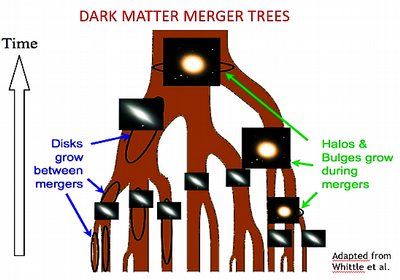Bridging theoretical models to key observables
The BiD4BEST ITN participants have world-leading expertise in all of themost cutting-edge techniques currently available to model the complex physics of galaxy formation and black-hole accretion. The aims of WP1-3 are to observationally constrain the number densities and intrinsic properties (e.g., accretion, wind power) of AGN as a function of time, luminosity, black hole mass and environment. The detailed comparison with the outputs of zoom-in simulations and extensive mocks generated from different underlying assumptions, will provide stringent constraints on the physics and evolution of AGN.

Task 4A: Constraining the growth rates and statistics of black holes and their hosts
Advanced statistical phenomenological models predict via a “continuity-equation” approach the abundances of active and quiescent black holes. The comparison with observations from WP1-3 will set firm constraints on the input AGN light curves (growth rates), and mergers of black holes and their host galaxies.
Task 4B: Probing the physics and impact of AGN feedback
We will make use of the Magneticum and EAGLE suites of cosmological zoom-in hydrodynamical simulations with a range of periodic volumes, numerical resolutions, and physical models. The simulations will adopt advanced smoothed particle hydrodynamics (SPH) codes that fully pass the spurious instability tests of traditional SPH models, include black hole accretion, and improved thermal/kinetic AGN feedback. Same initial conditions will also be run on grid-based codes (e.g., RAMSES). Simulations will be compared to WP1-3 specifically on: i) the level of star formation/gas mass as a function of AGN luminosity (WP1,3); ii) the dependence of outflows on AGN luminosity and host galaxy properties (WP2). A parallel task will be the development of a detailed analytical treatment of the expansion of AGN-driven ionized and molecular outflows in full cosmological semi-analytic models, a crucial improvement over present treatments.
Task 4C: Interactions and disc instabilities as AGN triggers
Various techniques will be adopted to explore the impact of interactions and disc instabilities in driving AGN activity (diagram above): i) hydro, large-scale simulations, ii) semi-analytic models (SAMs), which grow galaxies and black holes from first principles, and iii) semi-empirical models (SEMs), which assign galaxies to dark matter haloes via observationally-oriented relations (e.g., “abundance matching”). De-biased observables to compare with are: i) the scaling relations between black holes and galaxies; ii) AGN clustering at all scales; iii) the shape of the AGN accretion ratio distributions as a function of host galaxy properties.

